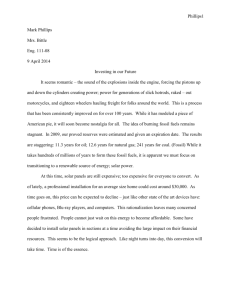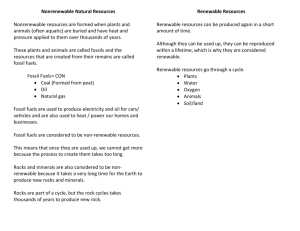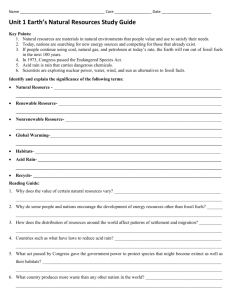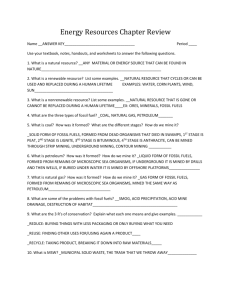Energy Sources & Types Worksheet: High School Science
advertisement
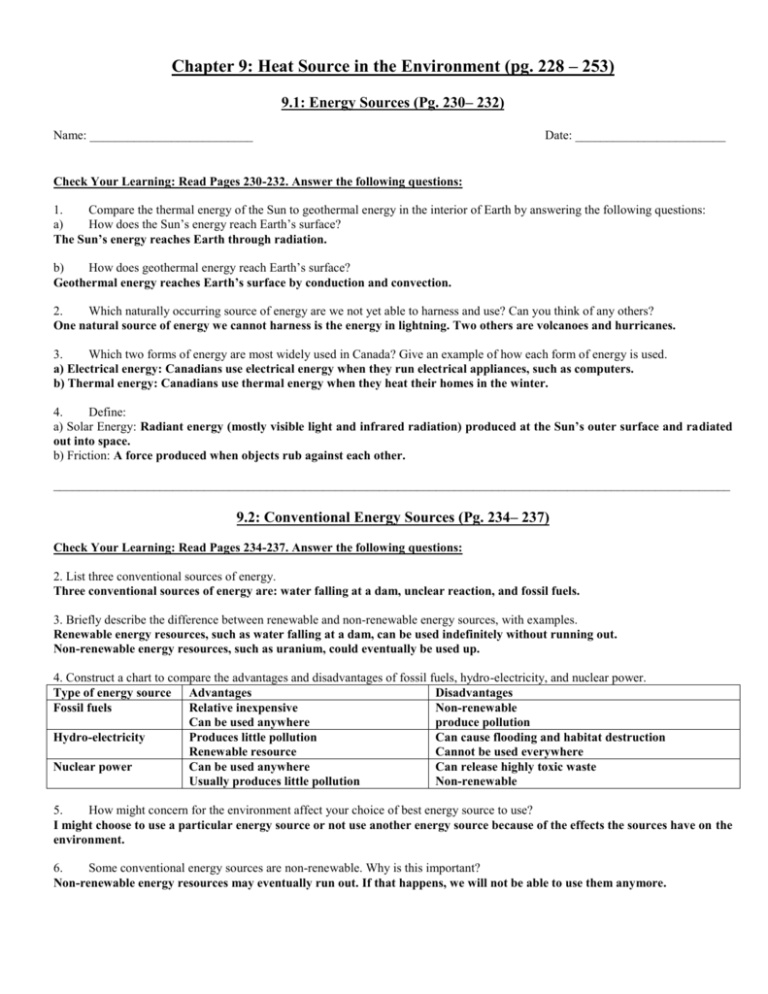
Chapter 9: Heat Source in the Environment (pg. 228 – 253) 9.1: Energy Sources (Pg. 230– 232) Name: __________________________ Date: ________________________ Check Your Learning: Read Pages 230-232. Answer the following questions: 1. Compare the thermal energy of the Sun to geothermal energy in the interior of Earth by answering the following questions: a) How does the Sun’s energy reach Earth’s surface? The Sun’s energy reaches Earth through radiation. b) How does geothermal energy reach Earth’s surface? Geothermal energy reaches Earth’s surface by conduction and convection. 2. Which naturally occurring source of energy are we not yet able to harness and use? Can you think of any others? One natural source of energy we cannot harness is the energy in lightning. Two others are volcanoes and hurricanes. 3. Which two forms of energy are most widely used in Canada? Give an example of how each form of energy is used. a) Electrical energy: Canadians use electrical energy when they run electrical appliances, such as computers. b) Thermal energy: Canadians use thermal energy when they heat their homes in the winter. 4. Define: a) Solar Energy: Radiant energy (mostly visible light and infrared radiation) produced at the Sun’s outer surface and radiated out into space. b) Friction: A force produced when objects rub against each other. ____________________________________________________________________________________________________________ 9.2: Conventional Energy Sources (Pg. 234– 237) Check Your Learning: Read Pages 234-237. Answer the following questions: 2. List three conventional sources of energy. Three conventional sources of energy are: water falling at a dam, unclear reaction, and fossil fuels. 3. Briefly describe the difference between renewable and non-renewable energy sources, with examples. Renewable energy resources, such as water falling at a dam, can be used indefinitely without running out. Non-renewable energy resources, such as uranium, could eventually be used up. 4. Construct a chart to compare the advantages and disadvantages of fossil fuels, hydro-electricity, and nuclear power. Type of energy source Advantages Disadvantages Fossil fuels Relative inexpensive Non-renewable Can be used anywhere produce pollution Hydro-electricity Produces little pollution Can cause flooding and habitat destruction Renewable resource Cannot be used everywhere Nuclear power Can be used anywhere Can release highly toxic waste Usually produces little pollution Non-renewable 5. How might concern for the environment affect your choice of best energy source to use? I might choose to use a particular energy source or not use another energy source because of the effects the sources have on the environment. 6. Some conventional energy sources are non-renewable. Why is this important? Non-renewable energy resources may eventually run out. If that happens, we will not be able to use them anymore. 9.4: Alternative Energy Sources: Wind and Wave Energy (Pg. 242– 243) Check Your Learning: Read Pages 242-233. Answer the following questions: 2. Wind and water energy are renewable energy sources. Why is this so important? Using renewable energy source is important because people need to reduce their dependence on non-renewable energy sources, such as fossil fuels, which may no longer be available in the near future. 3. Wind and wave energy may be used to generate electrical energy. What is the ultimate source of energy for both wind and water waves? The Sun is the ultimate source of energy for wind and waves. 4. a) What is the best geographic location for wind turbines? Any spot that is very windy is a good location for wind turbines. The shores of oceans and large lakes as well as mountaintops and open plains are all very windy. b) What is the best geographic location for water turbines? Any spot that has a constant source of fast-running water is a good location for water turbines. This includes fast-flowing rivers, areas with a large tidal range, or areas with strong ocean currents. 9.5: Alternative Energy Sources: Solar Energy (Pg. 244– 245) Check Your Learning: Read Pages 244-245. Answer the following questions: 1. Describe two differences between passive solar heating and active solar heating systems. a) Passive systems require no special equipment, but active systems require either hot water panels or solar cells. b) Unlike active systems, passive systems do not need other forms of energy to operate. 2. In Canada, which side of a building receives the most radiant energy from the Sun? In Canada, the south-facing side of a building receives the most radiant energy from the Sun. 3. What type of energy is produced from radiant energy in photovoltaic panels? Photovoltaic panels produce electricity from radiant energy. ____________________________________________________________________________________________________________ 9.6: Alternative Energy Sources: Geothermal Energy (Pg. 246– 247) Check Your Learning: Read Pages 246-247. Answer the following questions: 2. What are the two technologies that use geothermal energy? Geothermal power plants and geothermal heat pumps are two technologies that use geothermal energy. 3. Describe three different uses for a heat pump. a) A heat pump can be used as an air conditioner if it transfers thermal energy from the air inside a building to the air outside the building. b) It can be used for refrigeration if it transfers thermal energy from inside a refrigerator to outside the refrigerator. c) It can be used to heat a building if it transfers thermal energy from deep underground to the air inside the building. 4. Describe the relationship between soil temperature and depth. Generally, the greater the depth, the less variation there is in soil temperature, but the ground temperature at the same depth at two locations may not be the same. In the summer months, soil close to the surface can be much warmer than soil several metres below the surface. 5. Describe two advantages and two disadvantages of using a geothermal heat pump to heat and cool a home. Advantages: Heat pumps are very efficient. They are inexpensive to use. Disadvantages: Heat pumps are expensive to install. They may be difficult or expensive to repair. 9.7: Alternative Energy Sources: Biofuels (Pg. 248)) Check Your Learning: Read Pages 248. Answer the following questions: 1. What raw materials can be used to produce biofuels? Any kind of plant or animal material can be used to produce biofules. 2. Why are biofuels becoming a popular alternative source of energy? Biofuels may be better for the environment. They can be easily grown in many locations. 3. List two possible disadvantages of using biofuels. Biofuel crops may require large quantities of pesticides, chemical fertilizers, and fuel for farm equipment. A lot of farmland is needed to grow biofuels made from crop materials. ____________________________________________________________________________________________________________ Unit C: Heat in The Environment- PB: (Pg. 186 – 219) 9.1: Energy Sources: Pg. 190 a) b) c) Scientists cannot use lightening. People also cannot use the energy from earthquakes b/c we can’t predict earthquakes Scientists change other types of energy into electrical energy. These include mechanical, nuclear, and chemical energy. People use solar, geothermal, and chemical energy to heat buildings. Pg. 191 # 1: a) lightning b) chemical c) water d) radiant e) heat f) wind, clouds g) mimetic 9.2: Conventional Energy Sources: Pg. 196 1. Nuclear energy, hydro-electric energy, and thermal-electric energy. 2. A renewable energy resource can be used forever without running out. Example: Hydro-electric energy A no-renewable energy resource will eventually run out. Example: Fossil Fuels… Pg. 197: # 1 a) FF F) FF B) FF; N; HE G) N C) FF; N H) HE D) HE I) HE E) N J) FF 9.4: Alternative Energy Sources: Wind and Wave Energy Pg. 207 1) The sun heats the water and the land unevenly. This makes air moves around, which causes wind. Wind moves across water to make waves. 2) Wind turbines can be very big and noisy. They may be dangerous for birds. 4) Both are renewable resources. Neither one harms the environment. 9.5: Alternative Energy Sources: Solar Energy Pg. 211 1. Passive solar heating uses windows. Active solar heating uses equipment such as solar panels and cell panels. 2. Sunlight passes through large windows. The floor and the walls absorb the sunlight and transfer the radiant energy into thermal energy… 3. Yes. It is a source of energy that will never run out. 4. Solar energy can be used to 1) heat buildings and 2) create electricity Working with Solar Energy: Pg. 212 # 1 1. Solar hot water panels change radiant energy into thermal energy. 2. Photovoltaic panels change radiant energy into electrical energy. 9.6: Alternative Energy Sources: Geothermal Energy: Pg. 215 1) As you go deeper in the ground, the temperature stays more constant through the year. 3) It is renewable. It does not pollute the environment. 4) Geothermal power plants and heat pumps. 9.7: Alternative Energy Sources: Biofuels Pg. 218 a) Biofuels are made from plant or animal materials, such as corn. b) New crops can grow every year. c) Making biofuels uses land that could be used to grow crops. d) Corn; used vegetable oil. e) Biofuels are primarily used to replace gasoline and diesel as fuel for transportation. Pg. 219 # 1: a) Biofuel b) Ethanol c) CO2 d) Renewable Chapter 9: Chapter Review (pg. 252 – 253) e) Fossil fuel 1. List four fossil fuels. Coal, gasoline, diesel fuel, and natural gas. 2. Why are these fuels called fossil fuels? Fossil fuels are called fossil fuels because they form from the remains of organisms that lived hundreds of millions of yeas ago. The remains of organisms that have been preserved are called fossils. 3. What form of energy do fossil fuels contain? Fossil fuels contain chemical energy. 4. What forms of energy are produced when fossil fuels burn? Fossil fuels release thermal energy and light energy when they burn. 1. a) Why is hydro-electric power considered a “clean” source of energy (Figure 1, pg. 252) Hydro-electric power plants produce little or no pollution. b) Why is hydro-electric power considered a renewable source of energy? The water in the dam is replaced continually by natural processes (the water cycle). 7. Describe ONE ways in which home builders may take advantage of passive solar heating. Home builders may build large windows on the south side of a house to let sunlight in during the winter. The windows can be blocked with blinds during the summer to keep the house cooler. The floors of the rooms with the south-facing windows can be made of energy-absorbing material to absorb the energy that comes in the window during the winter. 8. a) Name a heat pump that you use every day at home. A refrigerator. b) What is a geothermal heat pump, and how does it work? A geothermal heat pump is a device that can transfer thermal energy between a building and the ground. Water or another fluid is pumped through pipes deep in the ground, where the temperature remains fairly constant all year. During the winter, when it is colder outside than below the ground, thermal energy from the ground heats the water, and then the water transports that thermal energy to the house to heat it. During the summer, when it is hotter outside than below the ground, the water absorbs thermal energy from the house and transports it into the ground. 9. Why are fossil fuels the most common source of energy for heating and transportation today? Fossil fuels are the most common energy source today because they are cheap and readily available. 15. You are planning to install solar hot water panels on the roof of your home: a) Would you install the panels on the side of the rood that faces south or on the side of the roof that faces north? Explain. I would install the solar panels on the south side of the house. The sunlight is more intense on the south side of the house than on the north side, so putting the panels on the south side would allow them to harness more solar energy. b) What type of energy transformation will occur in the panels? Radiant energy will change to thermal energy in the panels. 17. a) What is a biofuel? Provide one example. A biofuel is a once-living material that can be burned as a source of energy, such as corn ethanol. b) State one similarity and one difference between biofuels and fossil fuels. Both biofuels and fossil fuels form from the remains of once-living organisms. Fossil fuels are non-renewable energy resources, but biofuels are renewable energy resources. c) State one advantage and one disadvantage of using biofuels as an energy source. An advantage to using biofuels is that they are renewable. A disadvantage is that growing the plants to make them requires a lot of land.



